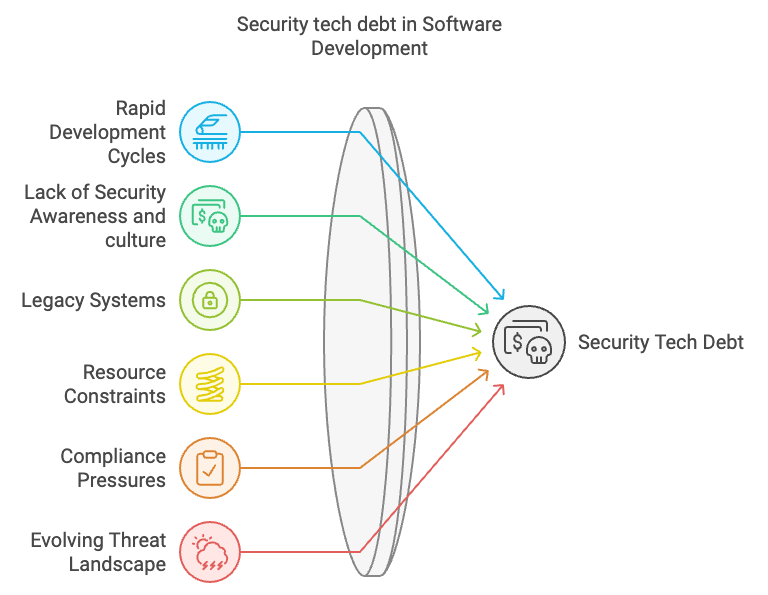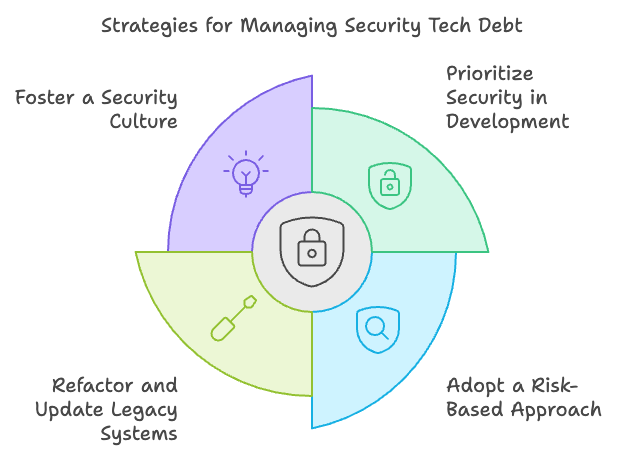From Startup to Enterprise: How to Escape the Security Tech Debt Trap

In the fast-paced world of software development, tech debt is a common issue that every engineering team faces sooner or later. Among the various forms of tech debt, security tech debt stands out as particularly critical due to the potential risks it poses. This article delves into what security tech debt is, how it is generated, strategies to effectively manage it, and the importance of prioritizing security, especially considering how it affects companies at different stages of their journeys.
What is Security Tech Debt?
Security tech debt refers to the accumulation of security vulnerabilities, weaknesses, and non-compliance within a software system. This type of debt arises when immediate pressures to deliver functionality lead to shortcuts or compromises in security. Like financial debt, security tech debt incurs "interest" in the form of increased risk, potential breaches, compliance failures and higher future remediation costs.

So how is security Tech Debt Generated?
There are points in the company journey when engineers ask themselves, how did we get to this point? And this is not single reason problem, but has many components:
- Rapid Development Cycles: Pressure to meet deadlines often leads to security being an afterthought. Quick fixes and bypassing thorough security reviews contribute to vulnerabilities. This affects more Startups and Scale-ups where finding product market fit and fast growth is key.
- Lack of Security Expertise: Inadequate training and a lack of dedicated security staff can result in the implementation of insecure coding practices and overlooked security considerations. Also the inconsistency in security practices across different teams or projects can lead to inconsistent application of security controls and processes if any.
- Lack of security awareness and culture: Many development teams may not have a strong understanding of security principles. This lack of awareness can lead to poor coding practices, insufficient threat modeling, and neglect of security best practices, ultimately contributing to the accumulation of tech debt.
- Legacy Systems: Outdated technologies and legacy code that were developed without modern security standards in mind contribute significantly to security tech debt. Legacy systems tend to be overlooked and maintaince of such systems is not prioritized. Operating system and libraries tend to be End of Life and not support provided by vendors aka "no security patches".
- Neglecting Regular Updates: Delaying updates and patches for third-party libraries and dependencies introduces vulnerabilities that could have been avoided. Sometimes the lack of proper testing processes, and the worry of incompatibility of newer versions with your system makes team to push these changes to a future that never arrive.
- Resource constraints: Limited budgets and personnel can hinder an organization's ability to invest in security. When resources are stretched thin, security initiatives may be deprioritized, resulting in tech debt as teams are unable to address known vulnerabilities or implement necessary security controls.

It mostly boils down to prioritising releasing product features, and focusing on other areas like availability and performance over Security, due to the perception of customers on the product experience. Security is not perceived as a problem if customer dont see it, while availability and performance could mean the difference when building a new product, particularly in the early stages of growth of a company.
Tech Debt at Different Company Stages
Security tech debt impacts companies differently depending on their stage of growth. Understanding these differences is crucial for tailoring effective strategies to deal with security technical debt.
Startups:
- Limited Resources: Startups often operate with limited resources and tight deadlines. This environment can lead to significant security tech debt as the focus is primarily on rapid development and market entry.
- Ad Hoc Security: Security practices may be inconsistent or ad hoc, increasing the risk of vulnerabilities.
Scale-Ups:
- Rapid Expansion: As companies grow, the complexity of their systems increases. The initial tech debt can quickly become unmanageable if not addressed.
- Increased Exposure: With growth, the potential impact of security breaches also increases, as the company handles more data and transactions.
Enterprises:
- Complex Systems: Large enterprises often have numerous legacy systems, each contributing to a substantial security tech debt.
- Regulatory Requirements: Enterprises are subject to stringent regulatory and compliance requirements, making security tech debt even more critical.
Also it is the case that if a company incurs in Security tech debt, this will grow together with the company through all the phases, reaching to the point that when the company is big and complex fixing the security tech debt will become big and complex as well. (Captain obvious)

So how can we deal with Security tech debt?
There are many things that we can do to reduce the Security tech debt, but we can group them in these four categories:
Prioritize Security in Development:
Shift Left/Secure by design: Integrate security practices early in the development process. Conduct regular security training for developers, introduce tooling in the developers processes, and provide visibility to the security posture of the code, libraries, images used in their projects.
Security Requirements: Clearly define security requirements and ensure they are part of the acceptance criteria for every project.
Threat Modeling/Design reviews: Conduct thorough threat modeling exercises to identify and prioritize security issues based on potential impact and likelihood.
Adopt a Risk-Based Approach:
Risk Assessment: Continuously assess and prioritize security tech debt based on the severity and exploitability of vulnerabilities. Evaluate security vulnerabilities based on their potential impact and exploitability. Focus on high-risk issues first. Context here is king, the more context you have the better.

Refactor and Update Legacy Systems:
Modernization Plans: Develop plans to refactor or replace legacy systems incrementally to adhere to current security standards.
Patch Management: Implement a robust patch management process to keep all systems and dependencies up to date.
Slipstreaming: Usually generic tech debt activity mitigation will involve keeping libraries and OS updated to the latest version, which on its own will reduce the number of vulnerabilities to the bare minimum. If there are initiatives for patching, upgrading system and libraries, ensure Security team contribute, participate and leverage those projects as it will contribute positively to reduce the security tech debt. For example if there is a Quality process or initiatives, this is a great opportunity to embed security there and join forces.
Golden Images and version drifting: In cloud native environments where is easier to manage the fleet with IaC and CI/CD pipelines the goal should be to have the latest Golden Image available, and monitor drifting against it. There are Secure containers and image providers like Seal.security and Chainguard.dev to ensure that you have a vulnerability free base golden images.
Foster a Security Culture:
Awareness Programs: Conduct regular security awareness programs to keep security top of mind for all team members.
Security Champions programs: Appoint security champions within development teams to advocate for security best practices and act as liaisons with security experts.
VIsibility on the security posture: You cant fix what you dont know. Surfacing the security posture of the systems, assets and components
Transparency across the organization: Communicate the importance of prioritizing security to all stakeholders, including leadership and engineering teams. Provide regular updates on the status of security tech debt and the efforts to address it, highlighting successes and areas needing attention.
KPIs and Metrics: Establish key performance indicators and metrics specifically for security tech debt reduction.
Incentives/Gamification: Create incentives for teams to prioritize and effectively manage security tech debt, recognizing and rewarding their efforts. Work with positive reinforcement instead of focusing on the negatives, in security we have a long track record of focusing on the negative, the bad and the ugly, we know that it doesnt work as we think, and it is time to move to positive reinforcement, celebrating the wins and achievements.
Allocating Time to Address Tech Debt
Managing security tech debt requires a deliberate allocation of time and resources. Without this dedicated effort, security issues can quickly accumulate, becoming more difficult and costly to address in the future, so the longer we wait the more difficult it will be for us. Here’s a couple of ways I am familiar with, to incorporate time allocation into your workflow:
Scheduled Tech Debt Sprints:
Dedicated Time: Allocate regular intervals (e.g., one sprint per quarter) specifically for addressing tech debt, with a significant focus on security issues.
Team Involvement: Ensure all team members understand the importance of these sprints and actively participate in identifying and resolving security tech debt.
Continuous Improvement Cycles:
Integrate into Agile Practices: Make tech debt remediation a part of the ongoing development process by including it in your backlog and sprint planning. Many companies allocated around 20-30% for dealing with general tech debt which includes security work. This is in theory, if you ask engineers usually it´s difficult to prioritize and use this time, as product features and other priorities tend to require all the sprint time, this will be highly related with the maturity of the Engineering and product organization.
Review and Reflect: Regularly review progress on tech debt reduction and adjust strategies as needed to ensure continuous improvement.
Bug Bash Sessions:
• Focused Collaboration: Organize regular “security bug bash” sessions where cross-functional teams gather to find and address security-related bugs and vulnerabilities. These sessions can create a sense of urgency and excitement around tackling security tech debt, as well as surface issues that might be overlooked during regular sprints.
• Reward & Recognition: Recognize and reward the team for contributions during these sessions. Positive reinforcement encourages team members to actively participate and prioritize security.
No matter your company’s stage, addressing security tech debt early is critical to sustaining long-term growth and resilience. Here are some tips for the different phases of company growth:
• Startups: Start integrating security into your development process today. Even with limited resources, a proactive approach will help avoid costly, unmanageable security debt in the future.
• Scale-Ups: As you scale, so does your exposure to security risks. Take immediate steps to assess and prioritize your security tech debt, ensuring you don’t carry vulnerabilities into your next growth phase.
• Enterprises: With complex systems and strict regulatory requirements, incremental improvements in your security infrastructure are essential. Focus on refactoring and patch management to modernize legacy systems and maintain compliance.
Remember, like financial debt, security tech debt incurs "interest" in the form of increased risk, potential security breaches, compliance failures and higher future remediation costs. Security debt grows alongside your company, but by dedicating time and resources now, you can keep it manageable. Whether you’re a startup, scale-up, or enterprise, make security a key part of your strategy—schedule tech debt sprints, dedicated % time for tech debt, foster a security culture, and celebrate every win. Your future self and company will thank you!
Thanks for reading! Subscribe for free to receive new posts and support my work.
